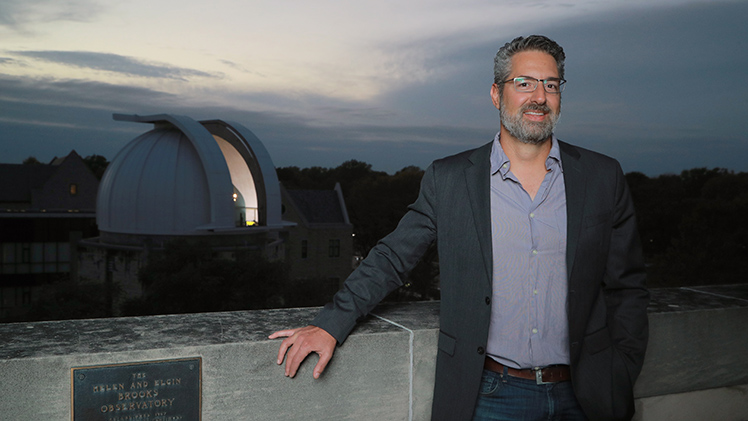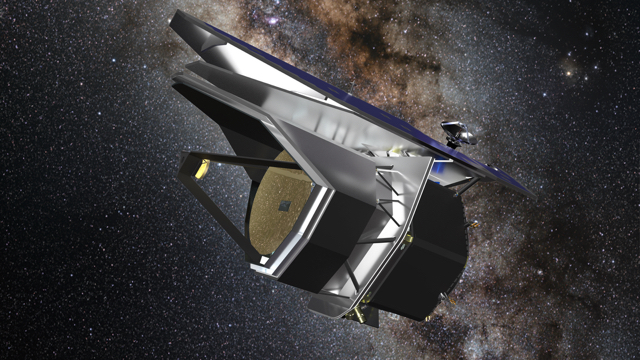Astronomers, administrators and aerospace engineers are on the clock to put together mission concept studies for two new space observatories, one of which the National Aeronautics and Space Administration (NASA) intends to put in orbit in 2032.
Among them is Dr. J.D. Smith, a professor in the Department of Physics and Astronomy and director of the Ritter Astrophysical Research Center at The University of Toledo.

Dr. J.D. Smith, a professor in the Department of Physics and Astronomy, is a collaborator on the science team for the Probe far-Infrared Mission for Astrophysics (PRIMA).
He’s a co-investigator on the Probe far-Infrared Mission for Astrophysics (PRIMA).
“One of the things that’s exciting about this mission concept is that there are such major gains in performance possible in the far-infrared,” said Smith, whose research into the physical conditions of interstellar material as a tool for understanding galaxy evolution often utilizes telescopes operating at these wavelengths. “We haven’t had far-infrared capabilities in space since the European Space Agency retired the Herschel Space Observatory in 2013. We’ve seen so many exciting technological advancements since then, meaning we’re looking at an even greater potential to uncover the secrets of the universe with PRIMA.”
PRIMA is one of two proposals that NASA selected for additional review earlier in October, when it announced that the teams behind PRIMA and the Advanced X-ray Imaging Satellite (AXIS) would each have 12 months and $5 million to submit a mission concept study that digs deeper into the practicalities and scientific potential of each probe.
NASA will then select one mission concept to proceed to construction in 2026, with a budget for mission costs that’s capped at $1 billion.
Smith is a co-investigator on the science team for PRIMA. Within this international team of about 25 astronomers, who are led by principal investigator Jason Glenn of NASA’s Goddard Space Flight Center, he is specifically co-leading a science working group on dust and metals.
He describes his role as the “fun stuff.”
“We’re making the case both that what we can do with this probe is important and exciting, but also that it is uniquely suited to tackle that kind of science,” he said.
PRIMA is proposed as a 5.9-foot telescope studying far-infrared wavelengths, a spectrum that would bridge a gap between existing radio and infrared telescopes including the James Webb Space Telescope. It’s intended to address questions about the origins and growth of planets, supermassive black holes, stars and cosmic dust.

The Probe far-Infrared Mission for Astrophysics (PRIMA) is one of two proposals for a new space observatory that NASA selected for additional review earlier in October. Photo courtesy of NASA/JPL-Caltch.
“It’s exciting for me because my research focuses on cosmic dust and what it can tell us about how galaxies form and evolve,” Smith said. “But most of what we know about gas and dust in the universe is pretty local. It gets harder to do this work as you push farther and farther into the universe and earlier and earlier in time. By the time you get to galaxies in the early universe, the radiation from these tiny smoke-like particles has just been inaccessible to us. That stands to change with PRIMA.”
PRIMA or AXIS will become the first in a new class of astrophysics missions under NASA’s Explorers Program. The recommendation for the new mission class, Probe Explorers, came out of the National Academies of Sciences, Engineering and Medicine’s 2020 Decadal Survey, Pathways to Discovery in Astronomy and Astrophysics for the 2020s.
The Probe Explorers mission class is intended to fill a gap between flagship missions like the James Webb Space Telescope and smaller-scale missions like the Uhuru and Cosmic Background Explorer missions, launched in 1970 and 1989, respectively, that won their investigators Nobel Prizes in Physics.
“NASA’s Explorers Program brings out some of the most creative ideas for missions that help us reveal the unknown about our universe. Establishing this new line of missions — the largest our Astrophysics program has ever competed — has taken that creativity to new heights,” said Nicola Fox, associate administrator of the Science Mission Directorate at NASA Headquarters in Washington. “Both of the selected concepts could enable ground-breaking science responsive to the top astrophysics priorities of the decade, develop key technologies for future flagship missions and offer opportunities for the entire community to use the new observatory, for the benefit of all.”